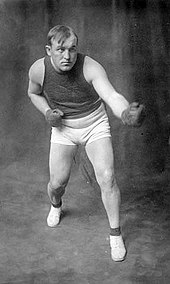Uppercut

An uppercut , the boxing uppercut (v. Engl. : UPPER above; cut chop, cut), is a punch, which has as a goal usually the chin of the opponent, and therefore in the vernacular as chin is known.
In technical jargon, the term “chin hook” is not used because a “hook” usually refers to a sideways hook with the leading hand and the target of hits is almost always the chin.
execution
The uppercut is made in an upward motion from the umbilical region, creating the shape of a hook before the fist hits the opponent's face or body. Other variants, e.g. B. in Muay Thai, are not hit from the stomach area. Instead, the fist in question falls from cover only as far as is necessary to gain sufficient momentum. Pulling the fist down to the stomach increases the distance and duration of the execution and with it the chances of the opponent to recognize the intention and to use the opened cover for a blow.
An uppercut is best performed from a short distance, as the greater the distance from the opponent, the greater the risk of missing it. An uppercut is most effective when it hits the opponent's chin , but the upper body , nose and eyes are also typical targets. It is one of the infight techniques.
Uppercuts are almost always about the punching hand, but there were or are boxers like Aaron Pryor and Ricardo López who regularly hit a left uppercut from normal display. Michel Trabant managed a one-punch-knockout with a left uppercut against the wildly charging Marc Waelkens.
Famous users
Among others, Joe Louis was known for his uppercut.
